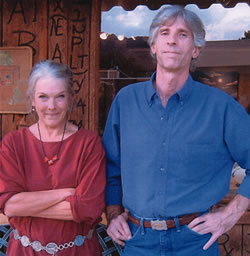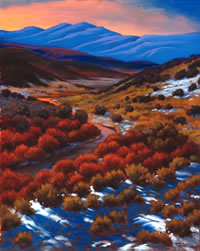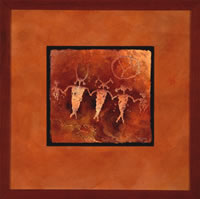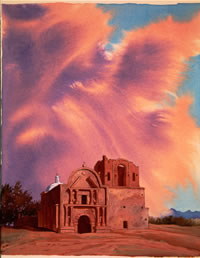
Loise Seiler and Tim Morse |
T.
J. Morse fits the image of a cowboy, not an artist. He speaks
quietly and meaningfully. He’s not eccentric, enigmatic
or boastful. He wears jeans a great deal and works in a building
covered in branding iron marks. L , he doesn’t seem
any more eager to challenge an art critic than he would be
to challenge an outlaw.
Although he may appear like a cowboy on the outside, Morse
harbors the soul of an artist. Through his portfolio, he depicts
a unique and beautiful vision of the world around him.
The landscapes he paints are lovely and accessible and
certainly don’t make any bold social commentary or
herald a new movement in culture.
What Morse’s prolific painting accomplishes, besides
pleasing the viewer’s eyes, is capturing the mysticism
of nature and how these Western landscapes affect the people
who see and live within them. Morse evinces a mastery of technique
and comfort in his medium to be distinguished as an artist,
but his interpretation of the West and its magic and majesty
are worthy of one who knows and roams the landscapes. This
must be what a cowboy sees.
 Because
of his father who was in the oil business, Morse has traveled
much of the West, starting in his birthplace of Wyoming
and covering territory as far south as Texas. Because
of his father who was in the oil business, Morse has traveled
much of the West, starting in his birthplace of Wyoming
and covering territory as far south as Texas.
Having always possessed an interest and ability in drawing
and painting, Morse dabbled in art, while working construction
as a young man. In his late twenties, he decided to pursue
a profession that would allow him to incorporate his interest
in art, and he received a B.A. in graphic design from the University
of Central Oklahoma.
With the ubiquitous use of computers over manual layout in
this field, Morse, a tactile person, found himself losing interest
and gravitating towards the Fine Arts. Watercolors, generally
considered the most difficult and ephemeral medium to paint
with, drew Morse in and he focused on depicting his beloved
Western landscapes in aquarelles.
Despite having an aunt who was a professional artist, it took
a long time before Morse considered following the same avenue.
In 1991, the native son returned to Moab, from where his parents
originated. Not yet committed to becoming a professional painter,
he put his manual and artistic dexterity into stone masonry.
Bolstered by the sale of a few paintings and the success
he achieved at his first serious exhibit at the Moab Arts
Festival, Morse partnered up with a friend, Jack Kleinke,
to open one of Moab’s first art galleries, The Overlook.
 It
seemed fitting that these two rugged Westerners chose a
venue in what had one time been a drinking establishment.
The wooden facade is covered in seared branding marks,
imbuing the gallery with a rustic, cowboy appearance. It
seemed fitting that these two rugged Westerners chose a
venue in what had one time been a drinking establishment.
The wooden facade is covered in seared branding marks,
imbuing the gallery with a rustic, cowboy appearance.
Although neither Morse nor Kleinke had much experience or knowledge
about running a gallery, they succeeded in keeping it afloat.
The first years were bumpy, but eventually The Overlook expanded
by adding a second location on Main Street. The gallery offered
Morse and his colleagues a venue to show their work, but the
commitment of running the gallery was eating into the time
Morse could spend painting.
Exhausted, he sold The Overlook eight years after he and Kleinke
had opened it. In order to reinvigorate his artistic inspiration,
Morse turned to a reclusive lifestyle, holing himself up in
Old Lasal, a community located in the nearby mountains. He
continued to live off his art, trading paintings for rent,
and this new solitude afforded him the time and energy to genuinely
focus on his painting.
This time period in Morse’slife is reflected in his
ethereal, pristine renderings of landscapes, particularly
scenes with aspens. His stylized watercolors depict the
contours of the trees, rivers and buttes he paints realistically,
and it is the hues that give the landscapes a surreal,
nostalgic appearance.
Morse reveals that the mountain and desert scenes he depicts
are his escape. This explains the immediate accessibility that
viewers have to his artwork because he creates images of places
that people are drawn to and offers them the same escape.
Rejuvenated by the solitude he found in the LaSals, Morse
moved to Tubac, Arizona, in 2003, where he managed to blend
the aspects he most liked about the two lifestyles he’d
recently experienced. He helped run a gallery, which gave
him the opportunity to learn more about the business, but
still have time to paint.
Through the gallery, he was also exposed to many different
styles of art, and had the chance of talking to various painters
about technique, all while improving his own.
The invigorating beauty of Moab called Morse back eventually.
He returned in July 2005 and partnered up with Louise Seiler,
a friend and fellow artist. Discerning that the environment
here is more favorable for promoting visual arts than it has
ever been, Morse and Seiler purchased The Overlook Gallery
together.
The gallery re-opened under Morse’s co-ownership
on June 15, 2006, favoring a bent towards western landscapes
and local artists.
Just as his business skills improved with time and experience,
so has his painting. In his most recent works, he continues
to explore his favorite subject matter through new techniques.
He has created a series of water media paintings depicting
Ancient Pueblo petroglyphs, whose ochre hues are so intense,
they cause a double take determining whether they are painting
or photograph.
The red ochres so strongly associated with Moab’s rocky
desert appear in almost every painting of Morse’s.
Another series of current paintings features stormy skies achieved
through the blending of pinks, purples and blues in watercolors.
He then paints a silhouette of the main feature, such as a
butter or and old mission, in the ubiquitous red ochre. He
adds details in mostly pastels in gouache, which allows him
to overlay light colors on dark.
 The
chiaroscuro effect of pastels on dark ochre gives dimension
to the subject, making it appear to pop out of the painting.
An excellent example of this new style Morse uses is “Storm
at Tumacacori,” where the old mission building, realistically
depicted, seems to bathe in a surreal sunlight. The
chiaroscuro effect of pastels on dark ochre gives dimension
to the subject, making it appear to pop out of the painting.
An excellent example of this new style Morse uses is “Storm
at Tumacacori,” where the old mission building, realistically
depicted, seems to bathe in a surreal sunlight.
The partnership between Morse and Seiler affords them both
time to paint since they share the responsibility of running
the business. For Morse in particular, who began The Overlook
when he and Moab were just budding in their new identities
as artist and tourist destination, taking possession once again
of this venue seems to symbolize coming full circle. Back in
the town of his roots, he evinces peace and contentment at
his ability to pursue his painting, make a living at it and
watch as the arts community in Moab continues to develop.
Like a rancher who has created his own domain out of scraggly
acreage, Morse can review his achievements and the artistic
territory he has tilled with warm satisfaction. He has evolved
as a painter, achieving a distinct, mature look to his enticing
paintings and he has created a venue that both furthers local
artists’ works and will help make Moab into an arts destination.
The Overlook Gallery is located on 83 E. Center Street
and can be reached at (435) 259-3861. Morse’s work
is also represented in Peaceful Escapes Gallery (Springdale,
UT), Sheryl Leonard Galleries (Prescott, AZ) and Los Reyes
Gallery (Tubac, AZ). His works can also be seen online
at www.tjmorse.com. |

 Because
of his father who was in the oil business, Morse has traveled
much of the West, starting in his birthplace of Wyoming
and covering territory as far south as Texas.
Because
of his father who was in the oil business, Morse has traveled
much of the West, starting in his birthplace of Wyoming
and covering territory as far south as Texas. It
seemed fitting that these two rugged Westerners chose a
venue in what had one time been a drinking establishment.
The wooden facade is covered in seared branding marks,
imbuing the gallery with a rustic, cowboy appearance.
It
seemed fitting that these two rugged Westerners chose a
venue in what had one time been a drinking establishment.
The wooden facade is covered in seared branding marks,
imbuing the gallery with a rustic, cowboy appearance. The
chiaroscuro effect of pastels on dark ochre gives dimension
to the subject, making it appear to pop out of the painting.
An excellent example of this new style Morse uses is “Storm
at Tumacacori,” where the old mission building, realistically
depicted, seems to bathe in a surreal sunlight.
The
chiaroscuro effect of pastels on dark ochre gives dimension
to the subject, making it appear to pop out of the painting.
An excellent example of this new style Morse uses is “Storm
at Tumacacori,” where the old mission building, realistically
depicted, seems to bathe in a surreal sunlight.